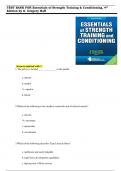TEST BANK FOR Essentials of Strength Training & Conditioning, 4th
Edition by G. Gregory Haff
(Answers marked with *)
1. The pelvis is located to the patella.
KA
a. inferior
b. medial
G
*c. superior
U
d. lateral
A
2.Which of the following is the smallest contractile unit of skeletal muscle?
a. myosin
*b. sarcomere
c. epimysium
d. sarcolemma TESTBANKSELLER.COM
3.Which of the following describes Type I muscle fibers?
a. inefficient and easily fatigable
b. rapid force development capabilities
c. high myosin ATPase activity
, *d. fatigue resistant with high aerobic energy supply
4.Which of the following describes the flow of blood?
*a. right atrium, right ventricle, lungs, left atrium, left ventricle, body
b. left ventricle, left atrium, body, right ventricle, right atrium, lungs
c. body, right ventricle, left ventricle, lungs, right atrium, left atrium
d. right ventricle, right atrium, body, left ventricle, left atrium, lungs
5.On average, how many times per minute does the SA node discharge at rest?
a. 10-30
b. 35-55
*c. 60-80
KA
d. 85-105 TESTBANKSELLER.COM
G
6.Which of the following are the two main divisions of the skeletal system?
U
a. upper and lower body
*b. appendicular and axial
A
c. medial and lateral
d. endergonic and exergonic
7. Some of the highest bone mineral densities have been seen in which of the following types of
athletes?
*a. gymnasts
b. cross-country skiers
c. swimmers
d. field hockey players
,8.What joint comprises the ankle and wrist joints?
a. hyaline
b. multiaxial
*c. biaxial
d. simple
9.Which of the following is the order of the phases of a muscle contraction?
a. contraction, relaxation, excitation-contraction coupling, recharge, resting
b. excitation-contraction coupling, relaxation, contraction, resting, recharge
*c. resting, excitation-contraction coupling, contraction, recharge, relaxation
KA
d. relaxation, recharge, excitation-contraction coupling, resting, contraction
TESTBANKSELLER.COM
G
10. The chronotropic effect is caused by stimulation of the nervous system
and causes the heart rate to .
U
a. parasympathetic; decrease
A
b. parasympathetic; increase
c. sympathetic; decrease
*d. sympathetic; increase
1. Two individuals of the same body mass are lifting weights. Assuming all other factors to be
equal, the person with tendons inserted on the bone the joint center should be
able to lift weight.
a. closer to; a heavier
b. medial to; less
c. laterally to; less
*d. farther from; a heavier
,2. Which anatomical plane divides the body into left and right sections?
*a. sagittal
b. transverse
c. perpendicular
d. frontal
3. An athlete in the weight room is performing the barbell bench press. If he moves a mass of 75
kg with an acceleration of 2 m/s², what force is he exerting?
a. 37.5 N
b. 37.5 kg·m-1·s²
KA
*c. 150 N
d. 150 kg·m-1·s²
G
4. Neural control affects the maximal force output of a muscle by determining which and how
many motor units are involved in a muscle contraction and the rate at which the motor units are
U
fired. These two factors are known as what, respectively?
A
a. rate coding; EMG
b. EMG; firing rates
*c. recruitment; rate coding
d. firing rates; recruitment
5. All of the following are considered to be advantages when using weight-stack machines
EXCEPT
a. design flexibility
*b. simulates real-life activities
TESTBANKSELLER.COM
c. reduced likelihood of injury
d. easy to use
,6. Which of the following is the resistive force encountered when one attempts to move an object
while it is pressed against another object?
*a. friction
b. inertia
c. obstruction
d. gravity
7. Eighty-five to ninety percent of all intervertebral disk herniations occur at what two locations?
a. T4-T5 and T5-L1
KA
*b. L4-L5 and L5-S1
c. T5-L1 and S1-S2
d. S1-S2 and L3-L4
G
U
8. An athlete produced 840 watts of power in 0.6 seconds. How much work did this individual
perform during the exercise?
A
a. 1400 kJ
b. 504 kJ
c. 1400 J
TESTBANKSELLER.COM
*d. 504 J
9. Which of the muscles or muscle groups have a fusiform pennation?
a. deltoid
*b. biceps brachii
c. rectus femoris
d. tibialis posterior
, 10. As an athlete's body size increases, which of the following describes how body mass and
muscular strength change?
a. Muscular strength increases more rapidly than body mass.
*b. Body mass increases more rapidly than muscular strength.
c. Muscular strength and body mass increase at the same rate.
1. The Krebs cycle occurs in which portion of the cell?
*a. mitochondria
b. nucleus
c. membrane
d. cytoplasm
KA
TESTBANKSELLER.COM
2. The law of mass action states which of the following?
G
a. A stronger action potential cannot produce a stronger contraction.
U
*b. The concentrations of reactants or products will drive the direction of the reactions.
c. The weight or mass of an object creates a stronger action potential.
A
d. The rate of product formation is greatly influenced by the concentrations of the
TESTBANKSELLER.COM
reactants.
3. An aerobic endurance athlete is trying to give himself a competitive edge over his opponents.
To improve his lactate threshold, what type of training should he engage in, and in what direction
would this shift his threshold?
a. long, slow distance; shifts to the left
*b. high intensity; shifts to the right
c. moderate intensity; shifts to the left
d. long, slow distance; shifts to the right




